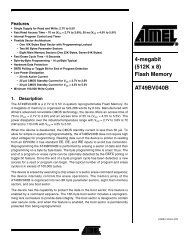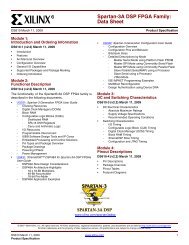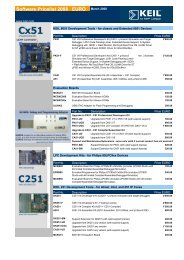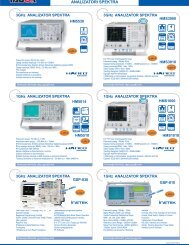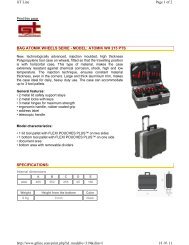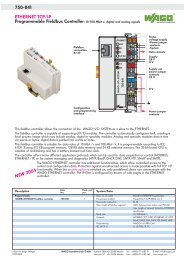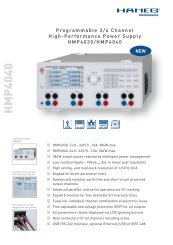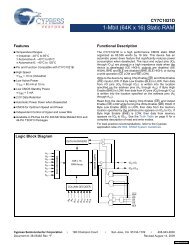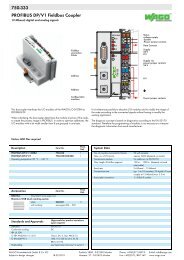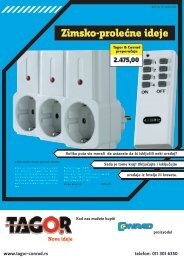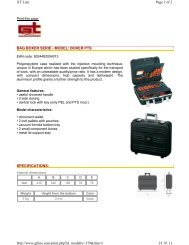PIC12F683 Data Sheet - Microchip
PIC12F683 Data Sheet - Microchip
PIC12F683 Data Sheet - Microchip
Create successful ePaper yourself
Turn your PDF publications into a flip-book with our unique Google optimized e-Paper software.
<strong>PIC12F683</strong><br />
3.0 OSCILLATOR MODULE (WITH<br />
FAIL-SAFE CLOCK MONITOR)<br />
3.1 Overview<br />
The Oscillator module has a wide variety of clock<br />
sources and selection features that allow it to be used<br />
in a wide range of applications while maximizing performance<br />
and minimizing power consumption. Figure 3-1<br />
illustrates a block diagram of the Oscillator module.<br />
Clock sources can be configured from external<br />
oscillators, quartz crystal resonators, ceramic resonators<br />
and Resistor-Capacitor (RC) circuits. In addition, the<br />
system clock source can be configured from one of two<br />
internal oscillators, with a choice of speeds selectable via<br />
software. Additional clock features include:<br />
• Selectable system clock source between external<br />
or internal via software.<br />
• Two-Speed Start-up mode, which minimizes<br />
latency between external oscillator start-up and<br />
code execution.<br />
• Fail-Safe Clock Monitor (FSCM) designed to<br />
detect a failure of the external clock source (LP,<br />
XT, HS, EC or RC modes) and switch<br />
automatically to the internal oscillator.<br />
The Oscillator module can be configured in one of eight<br />
clock modes.<br />
1. EC – External clock with I/O on OSC2/CLKOUT.<br />
2. LP – 32 kHz Low-Power Crystal mode.<br />
3. XT – Medium Gain Crystal or Ceramic<br />
Resonator Oscillator mode.<br />
4. HS – High Gain Crystal or Ceramic Resonator<br />
mode.<br />
5. RC – External Resistor-Capacitor (RC) with<br />
FOSC/4 output on OSC2/CLKOUT.<br />
6. RCIO – External Resistor-Capacitor (RC) with<br />
I/O on OSC2/CLKOUT.<br />
7. INTOSC – Internal oscillator with FOSC/4 output<br />
on OSC2 and I/O on OSC1/CLKIN.<br />
8. INTOSCIO – Internal oscillator with I/O on<br />
OSC1/CLKIN and OSC2/CLKOUT.<br />
Clock Source modes are configured by the FOSC<br />
bits in the Configuration Word register (CONFIG). The<br />
internal clock can be generated from two internal<br />
oscillators. The HFINTOSC is a calibrated<br />
high-frequency oscillator. The LFINTOSC is an<br />
uncalibrated low-frequency oscillator.<br />
FIGURE 3-1:<br />
PIC ® MCU CLOCK SOURCE BLOCK DIAGRAM<br />
OSC2<br />
External Oscillator<br />
FOSC<br />
(Configuration Word Register)<br />
SCS<br />
(OSCCON Register)<br />
OSC1<br />
Sleep<br />
LP, XT, HS, RC, RCIO, EC<br />
Internal Oscillator<br />
HFINTOSC<br />
8 MHz<br />
LFINTOSC<br />
31 kHz<br />
Postscaler<br />
IRCF<br />
(OSCCON Register)<br />
8 MHz<br />
111<br />
4 MHz<br />
110<br />
2 MHz<br />
101<br />
1 MHz<br />
100<br />
500 kHz<br />
011<br />
250 kHz<br />
010<br />
125 kHz<br />
001<br />
31 kHz<br />
000<br />
MUX<br />
INTOSC<br />
MUX<br />
System Clock<br />
(CPU and Peripherals)<br />
Power-up Timer (PWRT)<br />
Watchdog Timer (WDT)<br />
Fail-Safe Clock Monitor (FSCM)<br />
© 2007 <strong>Microchip</strong> Technology Inc. DS41211D-page 19



